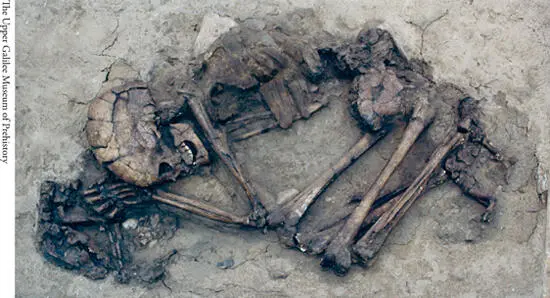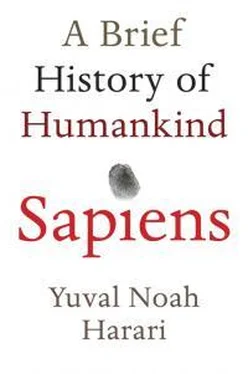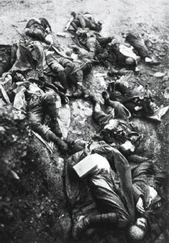It stands to reason that the ethnic and cultural variety among ancient hunter-gatherers was equally impressive, and that the 5 million to 8 million foragers who populated the world on the eve of the Agricultural Revolution were divided into thousands of separate tribes with thousands of different languages and cultures. 3This, after all, was one of the main legacies of the Cognitive Revolution. Thanks to the appearance of fiction, even people with the same genetic make-up who lived under similar ecological conditions were able to create very different imagined realities, which manifested themselves in different norms and values.
For example, there’s every reason to believe that a forager band that lived 30,000 years ago on the spot where Oxford University now stands would have spoken a different language from one living where Cambridge is now situated. One band might have been belligerent and the other peaceful. Perhaps the Cambridge band was communal while the one at Oxford was based on nuclear families. The Cantabrigians might have spent long hours carving wooden statues of their guardian spirits, whereas the Oxonians may have worshipped through dance. The former perhaps believed in reincarnation, while the latter thought this was nonsense. In one society, homosexual relationships might have been accepted, while in the other they were taboo.
In other words, while anthropological observations of modern foragers can help us understand some of the possibilities available to ancient foragers, the ancient horizon of possibilities was much broader, and most of it is hidden from our view. *The heated debates about Homo sapiens ’ ‘natural way of life’ miss the main point. Ever since the Cognitive Revolution, there hasn’t been a single natural way of life for Sapiens. There are only cultural choices, from among a bewildering palette of possibilities.
The Original Affluent Society
What generalisations can we make about life in the pre-agricultural world nevertheless? It seems safe to say that the vast majority of people lived in small bands numbering several dozen or at most several hundred individuals, and that all these individuals were humans. It is important to note this last point, because it is far from obvious. Most members of agricultural and industrial societies are domesticated animals. They are not equal to their masters, of course, but they are members all the same. Today, the society called New Zealand is composed of 4.5 million Sapiens and 50 million sheep.
There was just one exception to this general rule: the dog. The dog was the first animal domesticated by Homo sapiens , and this occurred before the Agricultural Revolution. Experts disagree about the exact date, but we have incontrovertible evidence of domesticated dogs from about 15,000 years ago. They may have joined the human pack thousands of years earlier.
Dogs were used for hunting and fighting, and as an alarm system against wild beasts and human intruders. With the passing of generations, the two species co-evolved to communicate well with each other. Dogs that were most attentive to the needs and feelings of their human companions got extra care and food, and were more likely to survive. Simultaneously, dogs learned to manipulate people for their own needs. A 15,000-year bond has yielded a much deeper understanding and affection between humans and dogs than between humans and any other animal. 4In some cases dead dogs were even buried ceremoniously, much like humans.
Members of a band knew each other very intimately, and were surrounded throughout their lives by friends and relatives. Loneliness and privacy were rare. Neighbouring bands probably competed for resources and even fought one another, but they also had friendly contacts. They exchanged members, hunted together, traded rare luxuries, cemented political alliances and celebrated religious festivals. Such cooperation was one of the important trademarks of Homo sapiens , and gave it a crucial edge over other human species. Sometimes relations with neighbouring bands were tight enough that together they constituted a single tribe, sharing a common language, common myths, and common norms and values.
Yet we should not overestimate the importance of such external relations. Even if in times of crisis neighbouring bands drew closer together, and even if they occasionally gathered to hunt or feast together, they still spent the vast majority of their time in complete isolation and independence. Trade was mostly limited to prestige items such as shells, amber and pigments. There is no evidence that people traded staple goods like fruits and meat, or that the existence of one band depended on the importing of goods from another. Sociopolitical relations, too, tended to be sporadic. The tribe did not serve as a permanent political framework, and even if it had seasonal meeting places, there were no permanent towns or institutions. The average person lived many months without seeing or hearing a human from outside of her own band, and she encountered throughout her life no more than a few hundred humans. The Sapiens population was thinly spread over vast territories. Before the Agricultural Revolution, the human population of the entire planet was smaller than that of today’s Cairo.

7. First pet? A 12,000-year-old tomb found in northern Israel. It contains the skeleton of a fifty-year-old woman next to that of a puppy (bottom left corner). The puppy was buried close to the woman’s head. Her left hand is resting on the dog in a way that might indicate an emotional connection. There are, of course, other possible explanations. Perhaps, for example, the puppy was a gift to the gatekeeper of the next world.
Most Sapiens bands lived on the road, roaming from place to place in search of food. Their movements were influenced by the changing seasons, the annual migrations of animals and the growth cycles of plants. They usually travelled back and forth across the same home territory, an area of between several dozen and many hundreds of square kilometres.
Occasionally, bands wandered outside their turf and explored new lands, whether due to natural calamities, violent conflicts, demographic pressures or the initiative of a charismatic leader. These wanderings were the engine of human worldwide expansion. If a forager band split once every forty years and its splinter group migrated to a new territory a hundred kilometres to the east, the distance from East Africa to China would have been covered in about 10,000 years.
In some exceptional cases, when food sources were particularly rich, bands settled down in seasonal and even permanent camps. Techniques for drying, smoking and freezing food also made it possible to stay put for longer periods. Most importantly, alongside seas and rivers rich in seafood and waterfowl, humans set up permanent fishing villages – the first permanent settlements in history, long predating the Agricultural Revolution. Fishing villages might have appeared on the coasts of Indonesian islands as early as 45,000 years ago. These may have been the base from which Homo sapiens launched its first transoceanic enterprise: the invasion of Australia.
In most habitats, Sapiens bands fed themselves in an elastic and opportunistic fashion. They scrounged for termites, picked berries, dug for roots, stalked rabbits and hunted bison and mammoth. Notwithstanding the popular image of ‘man the hunter’, gathering was Sapiens’ main activity, and it provided most of their calories, as well as raw materials such as flint, wood and bamboo.
Sapiens did not forage only for food and materials. They foraged for knowledge as well. To survive, they needed a detailed mental map of their territory. To maximise the efficiency of their daily search for food, they required information about the growth patterns of each plant and the habits of each animal. They needed to know which foods were nourishing, which made you sick, and how to use others as cures. They needed to know the progress of the seasons and what warning signs preceded a thunderstorm or a dry spell. They studied every stream, every walnut tree, every bear cave, and every flint-stone deposit in their vicinity. Each individual had to understand how to make a stone knife, how to mend a torn cloak, how to lay a rabbit trap, and how to face avalanches, snakebites or hungry lions. Mastery of each of these many skills required years of apprenticeship and practice. The average ancient forager could turn a flint stone into a spear point within minutes. When we try to imitate this feat, we usually fail miserably. Most of us lack expert knowledge of the flaking properties of flint and basalt and the fine motor skills needed to work them precisely.
Читать дальше




![Юваль Ной Харари - Sapiens. Краткая история человечества [litres]](/books/34310/yuval-noj-harari-sapiens-kratkaya-istoriya-cheloveche-thumb.webp)





![Юваль Ной Харари - 21 урок для XXI века [Версия с комментированными отличиями перевода]](/books/412481/yuval-noj-harari-21-urok-dlya-xxi-veka-versiya-s-ko-thumb.webp)


